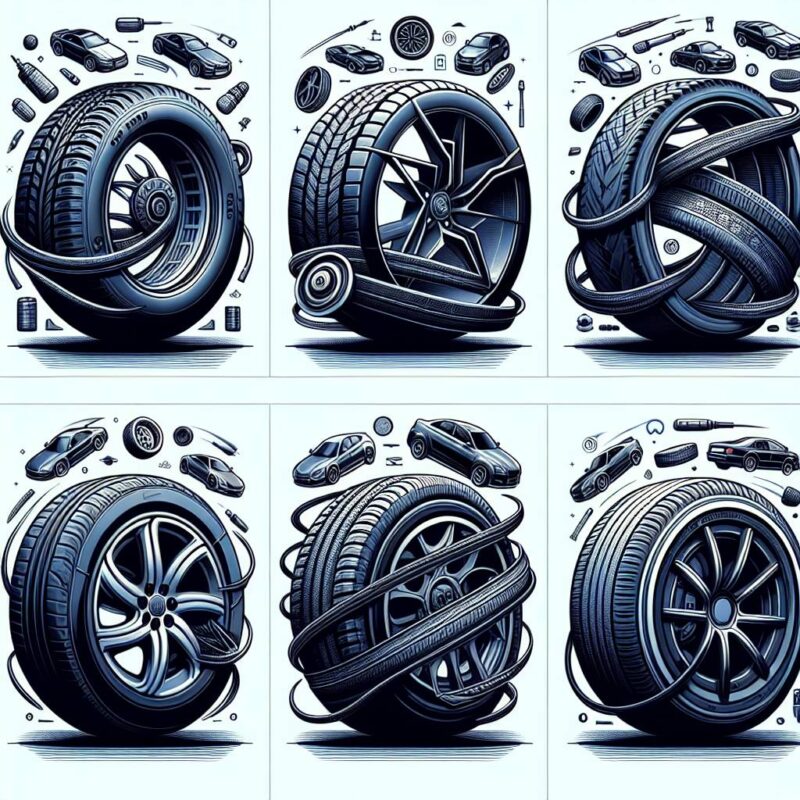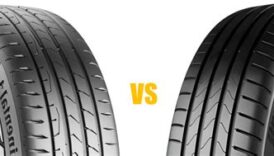Bridgestone vs. Continental vs. Goodyear vs. Pirelli vs. Michelin – Tyre Test

- Bridgestone vs. Continental vs. Goodyear vs. Pirelli vs. Michelin – Tyre Test
- Bridgestone Vs. Continental: Performance Metrics Explored
- Comparing Consumer Feedback on Bridgestone and Pirelli
- Goodyear Vs. Michelin: Understanding Tyre Durability
- The Role of Tyre Technology in Bridgestone Vs. Competitors
- Key Features of Bridgestone Tyres Unveiled
- Choosing the Right Tyre: Bridgestone Vs. Others
- Final Verdict: Bridgestone Vs. Continental, Goodyear, Pirelli, and Michelin
In the competitive landscape of tyre manufacturing, four leading names stand out: Bridgestone, Continental, Goodyear, Pirelli, and Michelin. Each of these brands boasts unique strengths, catering to diverse driving needs and preferences. This promotional article delves into a comprehensive comparison of these industry titans, examining crucial performance metrics, gathering consumer feedback, and exploring the latest advancements in tyre technology. From the unparalleled durability of Goodyear to the cutting-edge innovation of Bridgestone, we will uncover what sets each brand apart. Whether you’re a daily commuter, a performance enthusiast, or an off-road adventurer, selecting the right tyre is essential for safety and performance. Join us as we navigate this tyre test, providing you with valuable insights to make an informed decision for your next purchase.
Bridgestone Vs. Continental: Performance Metrics Explored
When comparing Bridgestone vs. Continental, performance metrics provide a critical lens through which we can evaluate their offerings. Both brands have established a strong market presence by delivering high-quality tyres, but distinct differences in performance can influence consumer choice.
To begin with, we can explore key performance metrics such as wet grip, dry traction, road noise, and tread wear. Understanding how these metrics stack up can significantly impact driver satisfaction and safety.
- Wet Grip: Bridgestone tyres are often praised for their excellent wet grip capabilities, thanks to advanced tread patterns and rubber compositions. Continental, on the other hand, employs innovative technologies that enhance hydroplaning resistance, providing consumers with reliable performance in rainy conditions.
- Dry Traction: Both brands have made significant developments in dry traction performance. Bridgestone generally offers tyres that respond effectively to high-speed cornering, while Continental tyres excel in providing a stable and controlled driving experience on dry surfaces.
- Road Noise: Noise levels can impact the driving experience notably. Bridgestone is designed with noise-reduction features to enhance comfort. Continental tyres also focus on quiet performance, but feedback varies among models.
- Tread Wear: The longevity of the tyre also plays a role in performance metrics. Bridgestone tyres tend to have a robust build that supports long tread life, while Continental tyres also provide decent lifespan but may vary based on specific model selections.
The performance comparison of Bridgestone vs. Continental highlights the strengths of each brand. Consumers should consider their specific driving conditions and preferences to determine which tyre brand aligns best with their needs.
Comparing Consumer Feedback on Bridgestone and Pirelli
Consumer feedback plays a vital role in assessing the real-world performance of tyres, and both Bridgestone vs. Pirelli have garnered significant attention in this aspect. Each brand has its own loyal group of supporters, which reflects not only the quality of the tyres but also the differing experiences that drivers have had.
When it comes to comfort, many users have praised Bridgestone for its smooth ride quality and low noise levels, which enhances overall driving experience. In various reviews, customers frequently highlight that Bridgestone tyres deliver excellent handling and stability, particularly in wet conditions.
On the other hand, Pirelli users often emphasize the sporty characteristics of their tyres. Many consumers appreciate the enhanced grip and performance that Pirelli tyres provide, particularly in cornering situations. This performance aspect makes Pirelli a favored choice among enthusiasts who prioritize driving dynamics.
Durability is another critical factor in consumer evaluations. While Bridgestone tyres are often seen as offering a longer lifespan, Pirelli tyres are recognized for their innovative technology that may increase performance, albeit with a trade-off in longevity for some models.
In terms of price, Bridgestone generally offers a wider range of options, catering to budget-conscious consumers and premium users alike. Pirelli, on the other hand, tends to align its offerings more closely with performance, which can translate into higher costs for certain models.
Overall, when comparing consumer feedback on Bridgestone vs. Pirelli, it’s clear that both brands excel in different areas. Preferences ultimately come down to specific driving needs—whether it’s comfort and durability or performance and sportiness. Understanding these consumer insights can help drivers make an informed decision based on their personal driving styles and needs.
Goodyear Vs. Michelin: Understanding Tyre Durability
When assessing tyre durability, two of the frontrunners in the market are Goodyear and Michelin. Both brands have established a solid reputation for producing tyres that not only perform well but also have a long lifespan. An analysis of their durability characteristics can help potential buyers make informed decisions.
Goodyear tyres are known for their engineering innovations that specifically enhance durability. The brand employs unique technologies such as their Durable Tread Technology, which helps resist wear and tear, especially in challenging driving conditions. Many users report that Goodyear tyres tend to deliver exceptional performance across a wide range of temperatures and road conditions.
On the other hand, Michelin tyres are often revered for their longevity and ability to maintain performance over time. The use of advanced rubber compounds in Michelin tyres contributes to their impressive wear resistance. According to consumer feedback, Michelin tyres can often outlast their competitors, making them a preferred choice for drivers looking for lasting value.
| Feature | Goodyear | Michelin |
|---|---|---|
| Durable Tread Technology | Yes | No |
| Advanced Rubber Compounds | No | Yes |
| Consumer Longevity Ratings | High | Very High |
| Price Range | $ | $$ |
While both Goodyear and Michelin offer durable tyres, they cater to slightly different consumer preferences. Goodyear may appeal more to those seeking innovative tread technologies, while Michelin is ideally suited for buyers prioritizing long-lasting performance and longevity. Regardless of choice, it’s crucial to consider each brand’s strengths and how they align with your driving needs.
The Role of Tyre Technology in Bridgestone Vs. Competitors
When evaluating the performance of tyres, the underlying technology plays a crucial role. In the competitive landscape of tyre manufacturing, brands like Bridgestone, Continental, Goodyear, Pirelli, and Michelin each leverage innovative technologies to enhance reliability, performance, and safety. Understanding how Bridgestone vs. competitors stack up in terms of technology can illuminate the strengths and weaknesses of each brand.
Bridgestone has invested heavily in advanced materials and manufacturing processes, focusing on innovation to improve grip, fuel efficiency, and durability. Their proprietary technologies, such as Dynamic Full Life Compound and Advanced Noise Control, aim to provide superior traction and drive comfort. This commitment to research and development allows Bridgestone to maintain a competitive edge.
On the other hand, Continental’s emphasis on intelligent tyre technologies aims to enhance safety and efficiency on the road. Features like ContiSense technology enable real-time monitoring of tyre pressure and temperature, improving safety by providing vital data to drivers. This focus on smart technology highlights Continental’s dedication to addressing modern driving challenges effectively.
Pirelli has made significant strides in the realm of performance with its Pirelli Cyber Tyre technology, which integrates sensors to monitor tyre conditions and provide feedback to the driver. This innovative approach ensures optimal performance under varying conditions, particularly in motorsport and premium markets.
Goodyear is known for its TredLife technology, designed to enhance tyre longevity through advanced tread patterns and all-weather design capabilities. This makes Goodyear tyres well-suited for diverse driving conditions, appealing to a broad range of consumers.
Michelin’s EverGrip technology is focused on maintaining grip even as tyres wear down. Their unique rubber compounds and tread designs are engineered to provide consistent performance over time, making them a popular choice for those prioritizing longevity and reliability.
| Tyre Brand | Key Technology | Main Benefits |
|---|---|---|
| Bridgestone | Dynamic Full Life Compound | Enhanced grip and durability |
| Continental | ContiSense | Real-time monitoring for safety |
| Pirelli | Pirelli Cyber Tyre | Performance feedback for optimal driving |
| Goodyear | TredLife | Longevity in diverse conditions |
| Michelin | EverGrip | Consistent performance as tyres wear |
The technological advancements found in Bridgestone vs. its competitors highlight the unique capabilities each brand offers. As consumers seek tyres that best fit their driving needs and preferences, understanding these innovations is vital in making an informed choice.
Key Features of Bridgestone Tyres Unveiled
Bridgestone tyres are renowned for their innovative technology and performance-driven design. When comparing Bridgestone vs. other leading tyre brands, several key features set Bridgestone apart from its competitors:
- Advanced Tread Design: Bridgestone incorporates cutting-edge tread patterns that enhance grip, reduce road noise, and improve water evacuation, contributing to superior driving stability.
- Durability: The construction of Bridgestone tyres emphasizes a robust build that withstands wear and tear, ensuring longevity even under demanding conditions.
- Fuel Efficiency: Bridgestone tyres are designed with a focus on lower rolling resistance, which aids in reducing fuel consumption, making them an eco-friendly choice for drivers.
- Winter Performance: Many Bridgestone models are equipped with technology tailored for winter use, providing excellent traction and handling on snow and ice, which is crucial when comparing Bridgestone vs. other brands in seasonal testing.
- Innovation in Materials: The use of high-performance materials in Bridgestone tyres enhances performance metrics, including grip and braking distance, further emphasizing their competitive edge.
Overall, the features of Bridgestone tyres highlight their commitment to quality and performance, making them a formidable choice in the Bridgestone vs. landscape of tyre manufacturers.
Choosing the Right Tyre: Bridgestone Vs. Others
Selecting the right tyre for your vehicle is crucial for optimal performance, safety, and comfort. When considering Bridgestone vs. other brands like Continental, Pirelli, Goodyear, and Michelin, various factors come into play. Here’s a breakdown of key considerations to help you make an informed decision.
| Criteria | Bridgestone | Continental | Pirelli | Goodyear | Michelin |
|---|---|---|---|---|---|
| Performance | Excellent wet and dry grip | Strong in handling and braking | Sporty performance, especially in high-speed conditions | Well-rounded, good in various conditions | Highly rated for comfort and quietness |
| Durability | High longevity, strong treadwear | Good life span, resistant to wear | Moderate; performance may reduce over time | Known for longer tread life | Exceptional durability, longevity expected |
| Price Range | Competitive pricing | Often higher due to technology | Premium pricing reflecting performance | Mid-range to premium | Typically on the higher end |
| Noise Level | Generally low noise | Slightly higher noise at speed | Can generate noise on performance tyres | Low noise levels | Renowned for quiet ride |
When choosing between Bridgestone vs. its competitors, consider your driving habits, the climate in your area, and the type of vehicle you own. If you prioritize performance and responsiveness, Bridgestone and Pirelli may be the brands to consider. However, if durability and comfort are your main concerns, Michelin or Goodyear might be more suitable.
It is essential to assess the specific advantages and disadvantages of each brand, ensuring that your tyre choice aligns with your personal driving needs and preferences. Always consult with a tyre expert or review user feedback to make the most informed decision.
Final Verdict: Bridgestone Vs. Continental, Goodyear, Pirelli, and Michelin
When it comes to choosing the best tyres for performance, safety, and longevity, the competition between Bridgestone, Continental, Goodyear, Pirelli, and Michelin is fierce. Each manufacturer brings unique strengths and capabilities to the table, making the decision a complex one for consumers.
Bridgestone vs. its rivals offers a blend of advanced technology, innovative designs, and consumer-focused solutions. Bridgestone tyres are known for their strong performance metrics across various categories, including handling, braking, and durability, setting a competitive standard against Continental’s engineered precision and Goodyear’s reputation for tread longevity.
On the other hand, Pirelli focuses heavily on high-performance tyres, making them a popular choice among sports car enthusiasts, while Michelin continues to lead in fuel efficiency and environmental sustainability. Each brand also garners varying degrees of consumer feedback, which reflects personal experiences and expectations from their respective products.
| Brand | Strengths | Ideal For |
|---|---|---|
| Bridgestone | All-round performance, innovation | General driving conditions |
| Continental | Precision engineering, safety features | Enhanced grip and control |
| Goodyear | Durability, tread lifespan | Long road trips, varied terrains |
| Pirelli | Sport performance, handling | High-performance vehicles |
| Michelin | Fuel efficiency, sustainability | Eco-conscious drivers |
The choice between Bridgestone vs. the competition hinges on individual driving needs and environmental conditions. While Bridgestone continues to excel in a well-rounded approach to tyre performance, evaluating what each brand specifically offers can guide consumers towards making the most suitable choice for their vehicle and driving style.






